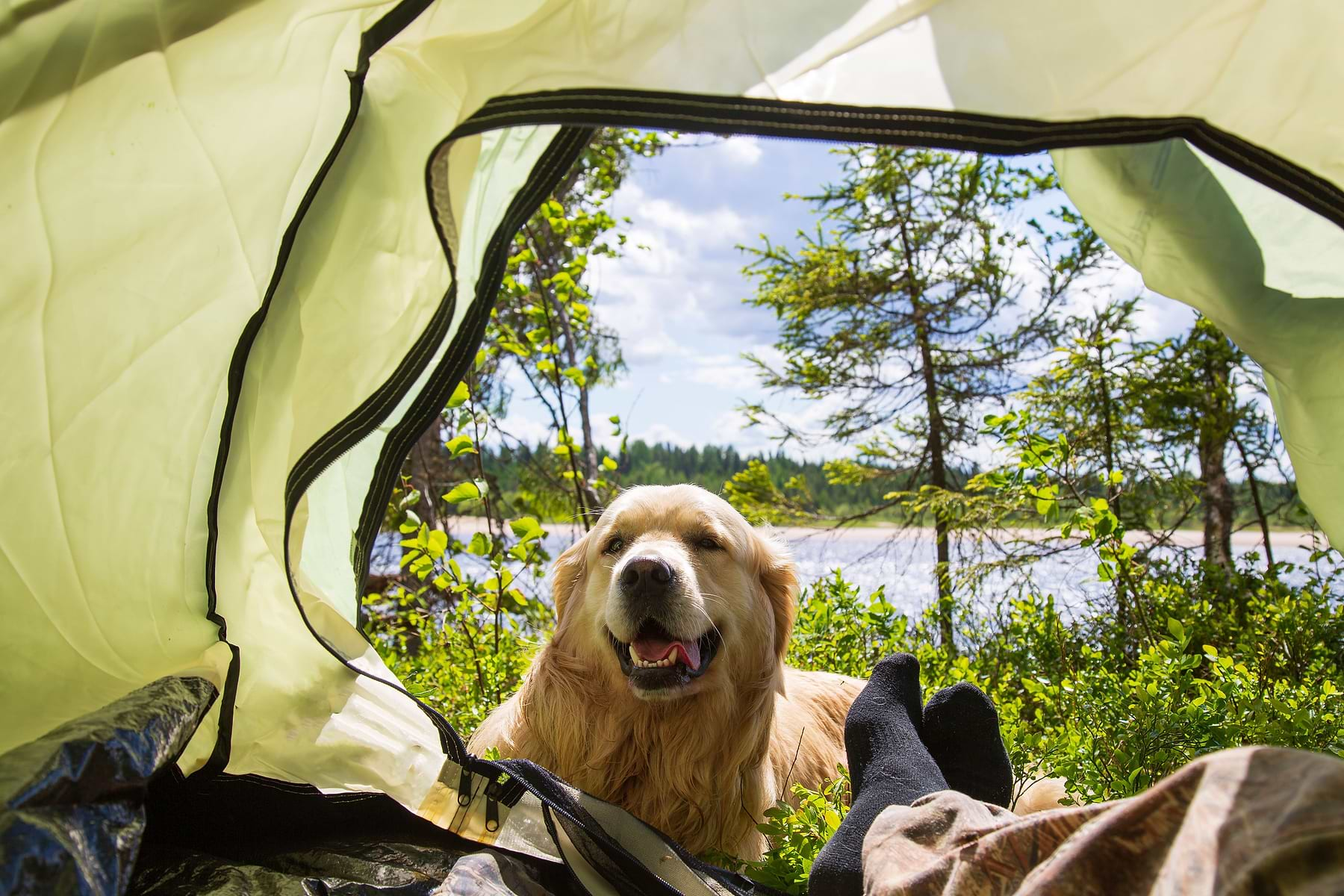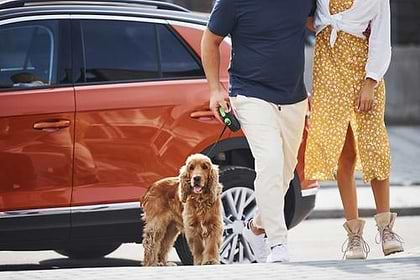
For those of us who love nothing more than escaping into nature, camping is just what the doctor (or veterinarian) ordered. A trip outdoors is calming, centering, and can be a wonderful way to recharge from our daily life. It stands to reason that we would want to include our puppies in the fun, but there are some necessary steps to consider before making the trek together.
Bring Their Home Away From Home
Camping is a fun and exciting activity to do with your puppy, but when you play hard, you have to rest hard too. After a long day of hiking, swimming, or simply keeping each other company, your dog is going to need a cozy place to recharge. All of the newness of the outdoors can be overwhelming for a puppy, but you can counteract that by bringing their trusted crate along for the ride.
Crates offer puppies a steady and comfortable place to call home. Perhaps most importantly, in this case, is that crates are also often portable. Your dog already associates this space with comfort, safety, and security. Those are all feelings that they could use more of in this new environment.
What To Look For in a Portable Puppy Crate
In order to bring your puppy’s crate camping with you, it is going to have to be easily transported. As a result, you are going to want to look for crates that are collapsible without ever sacrificing quality. The space has to be easy to move and store, but it has to be comfortable for your puppy as well.
Speaking of puppies, these younger animals have different needs in a crate than their adult dogs. A dog should be able to stand up and turn around in their crate, but it should not be much bigger than that.
Otherwise, your pet’s natural denning instincts will not be triggered. This is exactly why all Diggs crates come complete with a puppy divider that can be installed to make the space fit your pet perfectly.
Have More Than Enough Food and Water for Everyone
Camping is an activity that is meant to center and ground us, all while we get to experience the peace of the outdoors. Few feelings can put a damper on that peace quite as fast as being hungry or thirsty, and this is also true for our dogs. Dogs are driven primarily by instinct, so when their needs are not being met, it is nearly impossible to focus on anything else.
Be prepared to take frequent food and water breaks for both you and your puppy. This will ensure that everyone is having a good time while also being fully comfortable and taken care of.
When it comes to camping, we give up a certain amount of control over to mother nature; that’s part of the fun of it! We get to connect fully with our surroundings while enjoying the sights and smells around us. However, by giving up this control, we must also recognize that unforeseen events can happen. In recognition of this, it is best to prepare as much as possible ahead of time.
Take an excess of food and water with you. If you feel like you are packing a silly amount, then you are probably on the right track. You never know what could happen, and the last thing anyone wants is to be caught unawares without the necessary supplies.
Puppies grow more and more seemingly by the second. Not only that, but camping is also an environment where they are exposed to the elements and likely getting near-constant exercise. When you put all of these components together, you are going to need a lot of puppy food.
How Much Food and Water Do Puppies Need?
The exact amount of food that your puppy needs is of course going to depend upon their breed, size, and exercise level. For further clarity and a more specific diet plan, be sure to talk to your puppy’s vet. That way, you can set your dog up from the beginning for a healthy and happy life.
While it is always best to get specifics from your dog’s veterinarian, there are some general rules of thumb that can typically be followed. Puppies below three months of age will need a special puppy formula, and they should be fed four times throughout the day. As your dog ages, the four daily feedings will eventually transition to three and they will reach their final schedule at two feedings per day.
In terms of water, you should always have a drink available whenever your puppy wants one. It is integral that they stay properly hydrated, or else they could be at risk for heat exhaustion.
What Is Heat Exhaustion in Dogs?
Heat exhaustion occurs when the body’s internal temperature rises too high. As a result, the body is no longer able to regulate its own temperature. When your puppy shows signs of heat exhaustion, it is crucial to act fast. Otherwise, the heat exhaustion could easily turn into a heatstroke.
If your puppy begins to display signs of exhaustion, that is a clear indicator that it is time to rest. Some of the most common signs of heat exhaustion in dogs include:
- Excessive panting
- Dry nose
- A rapid heart rate
- Dizziness
- Drooling
- Lethargy
If a puppy’s heat exhaustion is not tended to sooner rather than later, it can progress into heatstroke, leading to a coma or even worse. As soon as you notice any of these symptoms, take your dog out of the hot environment however possible, and offer them an abundance of cool water to drink.
How To Keep Your Puppy Safe While Camping
Whenever you are outside with your puppy, safety is the number one priority. Whether you are just out for a short walk or are taking an extended camping trip together, everyone’s protection takes precedence.
As a result of this, pet parents have to make some preparations before taking their puppies outside. These preparations span from steps that you should take during your camping adventure to what you should do beforehand.
Get All of Their Vaccinations Ahead of Time
Part of the appeal of heading outdoors is seeing the wildlife. However, being near other animals can feel very different if your dog has not yet gotten the necessary vaccinations. Rabies and distemper are both dangerous diseases that your dog could pick up from other animals. Luckily, both of these can be avoided by having your dog vaccinated ahead of time.
Depending on your puppy and the vaccines, it might take multiple visits to the veterinarian to get them all set. For instance, smaller dogs will need to have their vaccinations spread out over a longer period of time.
Be sure to talk with your veterinarian to create a plan that works best for everyone involved. However, this possible delay is something to keep in mind before planning a camping trip.
Protect Them From Fleas, Ticks, and Heartworm
It is true that the great outdoors has so much to offer, but it also has some less pleasant risks that have to be addressed. Your dog could easily pick up pests such as fleas and ticks while exploring outdoors. These bugs are uncomfortable for your dog and could lead to serious complications. To avoid this, look into a trusted flea and tick prevention method.
You can talk to your vet about a prescription method, or you can opt for a collar or topical treatment. Keep in mind that while these bugs are more prevalent in the summer, they can still become a nuisance at any time of year.
When it comes to heartworm and other parasites, you can look into preventative measures and medications to keep your puppy from getting sick.
Beware of Potential Predators
When humans are camping, we typically do not have to fear much in the way of predators. Depending on where you are, a wayward bear could pose a threat, or at the very least make for a jarring sight during your otherwise peaceful hike. With dogs, there is unfortunately much more to keep an eye out for.
Large adult dogs are more likely to hold their own and not look like a meal to predators, but the same cannot be said for younger or smaller dogs. A puppy or a pet under about 20 pounds could be swept up by a bird or carried away by a coyote. These tragedies are possible, so it is our duty as pet parents to remain vigilant at all times.
If an area is especially overrun with predators who might target your dog, it might be best to try another area. After all, it is always better to be safe than sorry.
Train Your Puppy Ahead of Time
Since the great outdoors is so unpredictable, you and your dog have to be ready for anything and everything. All of the new sights and smells can be exciting for a puppy, but they still need to listen to you. Otherwise, you might not be able to help if something unexpected were to happen.
You can create a stronger bond with your puppy while also helping them stay safe in the future by training them with basic commands. Teaching your dog to “lay down,” “sit,” and “stay” are all helpful directions for your puppy to know. Once you have those commands established, you can use them to redirect your dog’s focus. If a situation arises that is potentially unsafe for your puppy, quickly telling them to sit could help maintain the peace.
Do Not Over Exhaust Your Puppy
We all like to think of our puppies as boundless balls of energy, but that is not always the case. Some dogs will have more energy than others, but even the most hyperactive canines will need a break from time to time.
If you have ever seen a pet get the “zoomies,” then you know energy can come in wild bursts. This is not necessarily an ideal situation in terms of camping. If you and your dog are going on a longer hike in the wilderness, that requires a level of endurance that your puppy simply might not have yet. This endurance can come with time, but it is crucial for pet parents to not over-exhaust their puppies in the present.
Since puppies have a reputation for constant energy, it can be easy to accidentally give them too much exercise without anyone noticing. This can dehydrate your dog or cause strain on their growing body.
It is worth noting that over-exercise is possible in adult dogs as well. A dog of any age can become overtired due to exertion or heat exhaustion. This is especially true in a camping environment, where you might not have the ability to enter a temperature-controlled shelter.
How Can You Make Sure Your Puppy Is Getting the Right Amount of Exercise?
A great way to ensure your puppy is getting the most out of the experience without becoming uncomfortable is to allow them to set the pace. Rather than guiding them with the leash, allow them to inform your speed. This will guarantee that you are not accidentally walking too fast for your puppy, and possibly causing issues like arthritis or hip dysplasia in the long run.
Know your dog and their typical energy levels. Just because you are enjoying the great outdoors together does not mean this is an opportunity to greatly exceed their usual exercise regimen.
Go Take a Hike
When done right, camping with your puppy can be a source of wonderful memories for years to come. By taking all of these tips into account before actually heading out, you can ensure a positive, fun, and most importantly safe experience.
Sources:
5 Signs Your Dog Is Getting Too Much Exercise | PetMD
AKC Canine Health Foundation | Heat Stroke and Heat Exhaustion in Dogs
Rabies or Canine Distemper? | Cornell University College of Veterinary Medicine

The Diggs Team
We believe our dogs deserve safer, better designed pet products.
You might also like
Crate training tips, stories and inspiration
View all blogsIn Your Diggs
Share your photos with #DiggsPet and tag us @DiggsPet on IG and TikTok.


